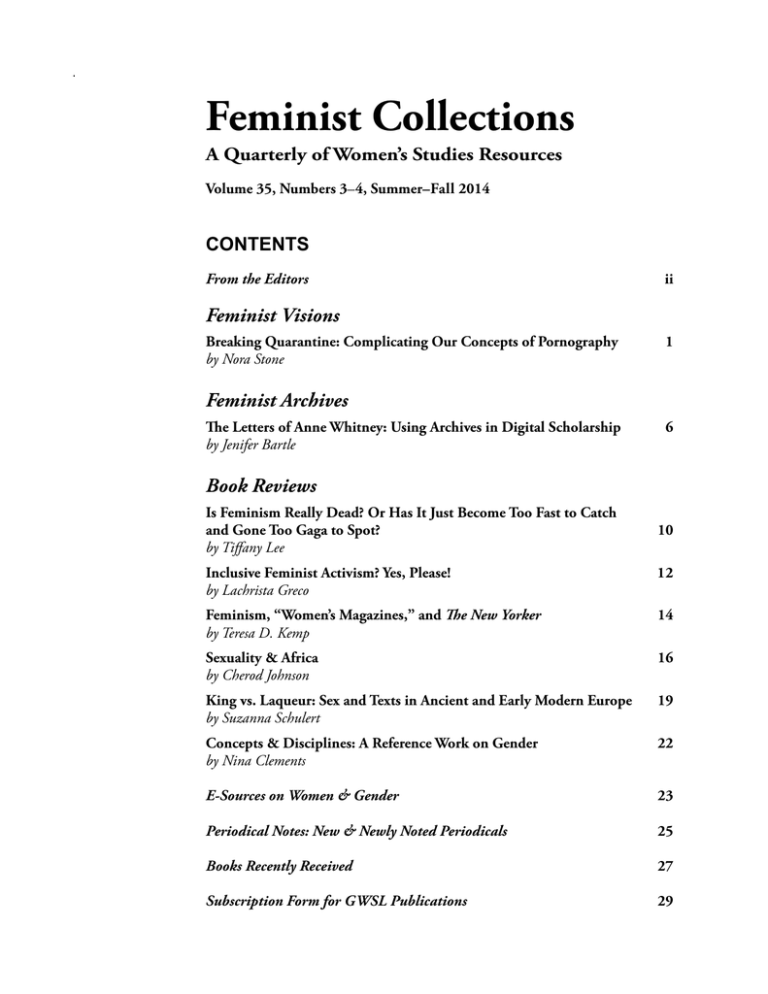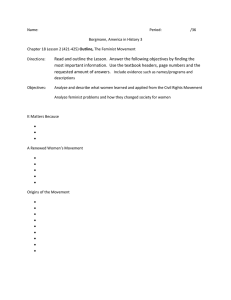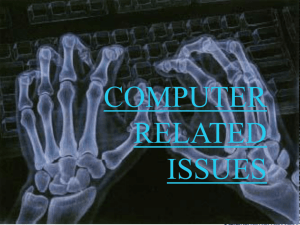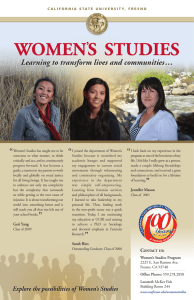
Feminist Collections
A Quarterly of Women’s Studies Resources
Volume 35, Numbers 3–4, Summer–Fall 2014
CONTENTS
From the Editorsii
Feminist Visions
Breaking Quarantine: Complicating Our Concepts of Pornography
by Nora Stone
1
Feminist Archives
The Letters of Anne Whitney: Using Archives in Digital Scholarship
by Jenifer Bartle
6
Book Reviews
Is Feminism Really Dead? Or Has It Just Become Too Fast to Catch
and Gone Too Gaga to Spot?
by Tiffany Lee
10
Inclusive Feminist Activism? Yes, Please!
by Lachrista Greco
12
Feminism, “Women’s Magazines,” and The New Yorker
by Teresa D. Kemp
14
Sexuality & Africa
by Cherod Johnson
16
King vs. Laqueur: Sex and Texts in Ancient and Early Modern Europe
by Suzanna Schulert
19
Concepts & Disciplines: A Reference Work on Gender
by Nina Clements
22
E-Sources on Women & Gender
23
Periodical Notes: New & Newly Noted Periodicals
25
Books Recently Received
27
Subscription Form for GWSL Publications29
Feminist Visions
Breaking Quarantine: Complicating Our Concepts of
Pornography
by Nora Stone
Anne G. Sabo, AFTER PORNIFIED: HOW WOMEN ARE TRANSFORMING PORNOGRAPHY & WHY IT
REALLY MATTERS. Winchester, UK: Zero Books/John Hunt Publishing, 2012. 245p. notes. pap., $22.95, ISBN 9781780994802.
Tristan Taormino, Celine Parreñas Shimizu, Constance Penley, & Mireille Miller-Young, eds., THE FEMINIST PORN
BOOK: THE POLITICS OF PRODUCING PLEASURE. New York: Feminist Press, 2013. 432p. pap., $22.95, ISBN
978-1558618183.
MUTANTES (PUNK PORN FEMINISM). 91 mins. 2009. Directed by Virginie Despentes. Distributed by Alive Mind
Cinema. Purchase: $21.21 for DVD or $9.95 for download at http://alivemindcinema.com.
I LOVE YOUR WORK. 6 hours. 2013. Directed by Jonathan Harris. Streaming online at http://iloveyourwork.net.
Purchase: 24-hour pass for $10.00; or three 24-hour passes plus a 13” x 19” limited-edition archival print of I Love Your
Work, signed by director Harris, for $300.00. To stage a screening, email concept to screenings@iloveyourwork.net.
W
ith the explosive popularity of
E. L. James’s erotic novel Fifty Shades
of Grey and its follow-ups, along with
excitement about its 2015 film adaptation, mainstream American culture
would seem to be becoming more accepting of women consuming sexually
explicit media. The numerous thinkpieces about the book’s craze, however,
often pointed out that Fifty Shades was
a Kindle bestseller, the kind of thing
that women don’t want to be seen reading. Thus, in many communities, there
is a disjuncture between what we want
to read or watch and what we want to
be seen reading or watching.
This ambivalence is even sharper
with regard to sexually explicit audiovisual material — otherwise known
as pornography. Although there is a
wider range of sexual representation on
television and in film than ever before
(including on premium cable series
such as Looking and Masters of Sex, and
in the French cinema du corps), pornog-
raphy remains quarantined in its own
space — a radioactive political issue
rather than a genre. The mainstream
media generally treats pornography
with suspicion, with most of its attention going to the horrors of internet
porn addiction. Myriad news stories
and articles imply, either implicitly
or explicitly, that the easy availability
of porn is bad for women because it
infects the brains of their husbands or
scars their children.
Pornography remains
quarantined in its own
space — a radioactive
political issue rather than
a genre.
In their own way, each of the
following materials combats these assumptions by focusing on the variety
of women who participate in the porn
industry and the variety of work they
Feminist Collections (v. 35, nos. 3–4, Summer–Fall 2014)
make. Anyone with a monolithic concept of pornography, the pornography
industry, or the pornography audience
will soon have that idea complicated by
any one of these works.
A
nne G. Sabo’s After Pornified:
How Women are Transforming Pornography and Why It Really Matters is a
straightforward study of porn made
by women. Sabo’s starting point is
journalist Pamela Paul’s book Pornified: How Pornography is Damaging
Our Lives, Our Families, and Our Relationships (Henry Holt, 2005), which
blamed the wide availability of pornography for numerous social and psychological problems. Rather than respond
to that blanket accusation, Sabo wants
to back the conversation up to a more
basic question about what porn is and
can be.
Picking up where Linda Williams’s
1989 landmark study, Hard Core:
Pleasure, Power, and the “Frenzy of the
Page 1
Feminist Visions
Visible,” left off, Sabo posits that female directors and producers have the
power to radically revise the dynamics of porn, thereby affecting viewers
positively rather than negatively. Sabo’s
Sabo wants to back the
conversation up to a more
basic question about what
porn is and can be.
criteria for this re-vision of porn are
twofold: high cinematic production
values and progressive sexual-political
commitment. Enfolded within those
two criteria are a number of normalizing ideas about what makes a film
good — realistic settings and costume,
flattering lighting, legible character development. Most interesting, though,
is the focus on narrative as an essential
part of a woman’s desired experience of
porn, which contrasts starkly with earlier feminist film theorists’ refutation of
narrative film generally.
porn, giving a fair assessment of the
landscape. The list of resources at the
back of the book is handy, collecting
the web addresses of women making
porn and the names of festivals that
show their work.
In a world where porn often circulates in small clips that are divorced
from their origins, with no indication
of financing or mode of production,
After Pornified is a helpful resource for
those looking to study women-made
porn. But although she offers a good
starting point, Sabo does not inter-
S
abo’s second criterion, progressive sexual-political commitment, is
clearer: equality of pleasure at least, if
not the woman taking control of the
sexual encounter; equality of representation, meaning the camera is not
lingering solely on the female body and
genitalia or looking down at the female
from the male point of view; and no
coercion or violence unless it is explicitly part of a character’s fantasy.
In order to highlight examples of
this preferred sort of porn, Sabo gives
concise histories of three of the most
pioneering filmmakers in the pornography industry: Candida Royalle in the
United States, Lene Børglun in Denmark, and Anna Span in Great Britain.
Sabo offers interviews with each, as
well as descriptions of their most famous films, and then examines a number of different genres of women-made
Page 2
rogate assumptions about what makes
porn good or what arouses women. She
avoids dealing with these issues because
her book is explicitly about porn made
by women, not necessarily “feminist”
porn. After Pornified is a clearly written
primer, not a definitive historical or
theoretical work.
The same issues affect Mutantes:
Punk Porn Feminism, a documentary
made by French pornographer Virginie Despentes. It opens with footage
from Images d’Ouverture, a French
performance piece, and from A Gun for
Jennifer, an independently produced
feature film about feminist vigilantes.
These clips set out two different poles
of sex-positive feminist media — punk
art pieces made in Europe, on the one
hand, and more mainstream femaleempowerment porn and feature films
on the other.
Mutantes surveys diverse modes
of sexual expression and political
engagement, via film clips, news footage, and interviews with female porn
producers, feminist sex workers, and
feminist media scholars in the United
States and France. The film begins with
the origin stories of some of the most
famed American porn revolutionaries:
Annie Sprinkle, Candida Royalle, Norma Jean Almodovar, Scarlot Harlot,
and others. Almost all of these women
speak about doing sex work without
censorship or victimization. Despentes
later brings in scholars Linda Williams
and B. Ruby Rich, who have not performed sex work but have documented
it and theorized about it.
Each woman is strikingly articulate about her decision to embrace sex
work, and each speaks with purpose
about combating oppression through
her work. A number of the interviewees consider producing porn to be a
major site of resistance and revolution,
while others look behind the history
of prostitution itself at the values that
enforce a sharp divide between acceptable, chaste womanhood and unacceptable, sexually active womanhood.
One subject to which the film
devotes little attention is the intersection of sex-positive feminism and race.
Sociologist Siobhan Brooks points out
One subject to which
Mutantes devotes little
attention is the intersection
of sex-positive feminism
and race.
Feminist Collections (v. 35, nos. 3–4, Summer–Fall 2014)
Feminist Visions
that women of color generally work
in the most dangerous parts of the sex
industry, such as street prostitution
(rather than call-girl work), and often
make less money than white sex workers. This is a significant topic that deserves further attention, but Mutantes
allows for little to no deviation from
its celebration of feminist sex workers
and sex-positivism. Instructors could
use this as a teaching moment for their
classes, to see if any students pick up
on the lack of attention to the experiences of American women of color.
T
he weakest part of the film is
the final third, in which Despentes
leaves the United States to investigate
the post-porn movement in Spain and
France. Punk aesthetics come to the
fore in post-porn work, which contrasts with somewhat more conventional porn made by women in the U.S.
However, neither the film’s voiceover
nor its talking heads offer enough
information about this art movement
to make it comprehensible to the layperson. Because American students
(and their professors) will likely be less
familiar with the cultural context for
European punk porn, the lack of clear
explanation handicaps the film.
Rather than offering an in-depth
study, Mutantes offers glimpses of
other worlds and voices that students
may have encountered only in readings. Showing part of the film in class
would be an excellent way to encourage students to learn more about the
movement to decriminalize prostitution, the growing number of female
porn entrepreneurs, how race and class
intersect with sex-positive feminism,
and the history of feminism in Western
nations.
I
Love Your Work is a survey of
another magnitude altogether. In this
innovative film project, director Jonathan Harris documented “a day in the
life” of nine different women, each of
whom is involved in making lesbian
pornography. Rather than focusing on
their careers in adult film, Harris folds
their performances and reflections on
making porn into the texture of their
daily lives. The camera accords as much
attention to performer Dylan Ryan
lugging a suitcase down a city street as
it does to Ela Darling masturbating in
a film studio surrounded by stylists,
makeup artists, camera operators, grips,
and producers. In fact, director Harris is so devoted to the idea of wideranging, cinema verité portraiture that
he deliberately captured video in tensecond clips throughout his day with
each woman. He did not even extend
his directorial authority by highlighting
the most dramatic or salacious moments; thus, a sense of randomness and
verisimilitude pervades the film and
increases the viewer’s intimacy with
the subjects, who are shown engaging
in such mundane activities as watching TV in a hotel room, chatting with
ing choices. I Love Your Work lives on
a website to which a visitor can buy a
ten-dollar pass to explore for 24 hours.
Once admitted into the website (which
allows only ten visitors per day), a
viewer can browse the footage in different ways. In “Timeline,” the tensecond clips are arranged in chronological order according to which day of
the week Harris followed each woman
through her life. The “Tapestry” page
is also chronological, but it does not
identify the subject or time of day, allowing for more random discovery as
the viewer dips in and out of a photomosaic of screenshots. In addition to
the video footage, each of the participants is profiled on the “Talent” page,
so a visitor can get acquainted with her
in a more conventional manner, via a
brief biography.
B
oth form and delivery method
are explicitly meant to imitate the
ways many users engage with internet
pornography, from browsing videos
by performer, to tensecond previews that
In classes on feminist media or the genre of entice the viewer to
click to watch more, to
personal documentary, Harris’s film could
the ability to move the
be used as an example of new possibilities of video playhead forward
digital documentary form and distribution to more interesting
parts. Applying this
that are attentive to subject matter and
form to a cinema verité
audience behavior.
documentary makes for
a fascinating film and a
humanizing experience.
Although the initial temptation might
friends outside a bar, and taking a pet
be to skip ahead to the explicitly erotic
to the hospital. There is no one way
sections, it is easy to be mesmerized
to watch this film, however, and no
reason why every visitor would feel the by the rhythm of each person’s life, to
enjoy the puzzle of what went on beneed to watch the more banal parts of
tween clips, having to work out what
these women’s lives.
is going on without recourse to any
extradiegetic material like captions or
arris ended up with about six
voiceover narration.
hours of footage from nine days of
shooting, and his method of delivering
this footage is just as daring as his film-
H
Feminist Collections (v. 35, nos. 3–4, Summer–Fall 2014)
Page 3
Feminist Visions
A fascinating film, I Love Your
Work functions better as a digital
media project than as a teaching tool
or research resource. In classes on
feminist media or the genre of personal
documentary, it could be used as an
example of new possibilities of digital
documentary form and distribution
that are attentive to subject matter and
audience behavior. It certainly fits the
current mode of internet porn consumption better than a linear narrative
or essay film would, but at times the
ten-second-clip gimmick gets in the
way, particularly during interviews.
Often the subject speaks directly to the
camera, in the manner of a conversation with the director/camera operator,
and discusses personal feelings about
porn, monogamy, or personal history,
but the viewer only gets tantalizing
clips of these revealing moments.
Lesbian porn star
Dylan Ryan of I Love Your
Work also features in the
most indispensable of the
four resources reviewed
here: The Feminist Porn
Book: The Politics of Producing Pleasure. The editors of
this volume have brought
together essays by feminist
porn producers and feminist porn scholars in a single volume, resulting in a
conversation that speaks to
the complexities of the pornography industry and the
uses of pornography once
it is made. The essays expand from a singular focus
on the process of making
feminist pornography to a
nuanced view of its circulation through the world.
In the introduction
to The Feminist Porn Book,
editors Tristan Taormino,
Celine Parreñas Shimizu,
Page 4
Constance Penley, and Mireille MillerYoung are upfront about their purpose,
as well as about their definition of
feminist porn: “Feminist porn creates
These diverse essays are written
in language likely to be
accessible to undergraduates
in women’s studies classes or
feminist film classes.
alternative images and develops its own
aesthetics and iconography to expand
established sexual norms and discourses… Feminist porn makers emphasize
the importance of their labor practices”
(p. 10). In brief, feminist porn is both
a filmmaking genre and a political
project. This focused definition allows
for contributors to interrogate assump-
tions about authorship, spectatorship,
representation, race, space, and education.
The introduction and the first few
essays lay out the history of feminist
pornography, as well as the opposing
tradition of anti-porn feminism, but
the rest of the essays move beyond the
basics to more specific issues. Many of
them are written in the first person,
but are no less incisive and useful for
that. A number of them address the
place of women of color, women of
size, and trans* women in pornography, offering both testimonies to selfempowerment through performance in
porn and sharp critiques of minority
representation in current porn.
In “A Queer Feminist Pig’s Manifesta,” professor of women’s studies
Jane Ward struggles with a conundrum: being aroused by
mainstream porn — the politically incorrect variety that
many are trying to combat.
She wonders, “Can we watch
sexist porn and still have
feminist orgasms?” (p. 132).
This honest confession of individual spectator preferences
leads her to advocate for a set
of self-aware viewing practices
based on Buddhist principles.
Other essays are attentive to
pornography in specific spaces, such as the classroom and
the therapist’s couch. Constance Penley reflects on her
years teaching a class about
pornography at the University
of California, Santa Barbara,
while Keiko Lane discusses
using pornography in her
work as a psychotherapist for
numerous queer, genderqueer,
and minority clients.
One particularly nice
pairing demonstrates the
value of an edited collection
such as The Feminist Porn
Feminist Collections (v. 35, nos. 3–4, Summer–Fall 2014)
Feminist Visions
Book: in a personal essay, Nina Hartley
writes about her reasons for becoming
a porn star and sex educator, making
such videos as Adam and Eve’s Guide
to Better Cunnilingus, Guide to Anal
Sex, and multi-part Guide to Sensual
Domination. In the following essay,
film scholar Kevin Heffernan traces the
history of educational sex films, from
independently produced exploitation
films marketed as “educational” during
the era of Hollywood self-censorship
(1920s–1960s), to more recent incarnations distributed on home video by
Adam and Eve and Vivid Video. Heffernan connects the censorship of sex
education materials to broader social
forces, including the medicalization of
women’s health and childbirth at the
turn of the century and concern over
the social effects of moving images following WWI. This synoptic history,
and Heffernan’s thoughtful descriptions of educational sex films, provides
necessary context to Hartley’s personal
exploration and message: “[S]ex is good
for you and the more you know about
it, the better it’s likely to be” (p. 236).
For these reasons, The Feminist
Porn Book comes out on top as the
resource with the most breadth and
depth of those reviewed here. Its diverse essays are written in language
likely to be accessible to undergraduates in women’s studies classes or
Feminist porn is both a
filmmaking genre and a
political project.
feminist film classes. The authors’
numerous perspectives — performer,
producer, educator, scholar, activist,
therapist — make a well-rounded case
for the importance of sexual representation and expression to feminism, and
vice versa.
I
f mainstream media and culture
paint a monolithic portrait of pornography, they also paint a depressingly
uniform portrait of women as the victims of pornography’s increasing availability. Each of these books and films
in its own way expands the possible
ways that women can relate to sexually
explicit audiovisual material. Whether
personal essay or survey film, historical
research or day-in-the-life documentation, these resources show how women
have been actively involved in the
creation and consumption of porn. As
the recent oral history of HBO’s pioneering Real Sex series demonstrates,1
women are not docile drones in service
to a singular, patriarchal pornography
— they shape their own representation
on-screen in myriad ways, and they
put porn to use in their own lives and
careers.
Note
1. Molly Langmuir, “Masturbation,
Nudists, and Street Interviews: An
Oral History of HBO’s Real Sex,”
Vulture, July 30, 2013. http://www.
vulture.com/2013/07/hbo-real-sexoral-history-masturbation-nudistsstreet-interviews.html
[Nora Stone is a Ph.D. candidate in the
film area of the Department of Communication Arts at the University of
Wisconsin–Madison. She was named
2013 Jarchow Fellow in the Wisconsin
Center for Film and Theater Research,
which resulted in a digital exhibit on the
Center’s papers of Emile de Antonio. She
teaches digital media production and
worked as production designer on a 2013
independent feature film, Sabbatical.]
Miriam Greenwald
Feminist Collections (v. 35, nos. 3–4, Summer–Fall 2014)
Page 5








